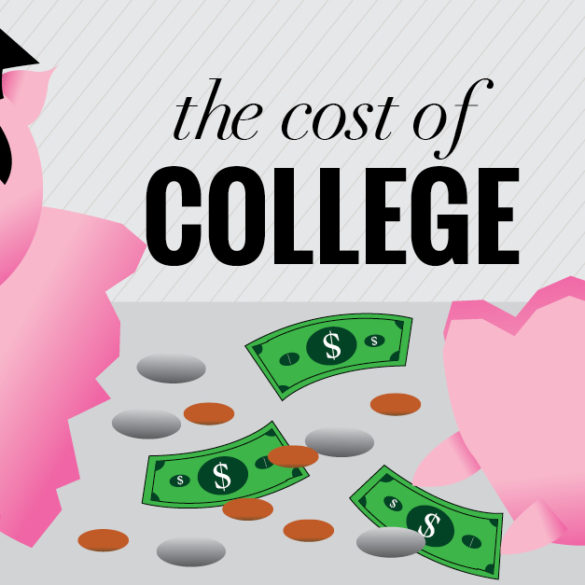It’s no secret that secondary education is expensive. More than half of students today think they aren’t getting the most bang for their buck, according to a Pew Research study. Millennials find themselves facing a choice: to spend the money to pay for university, to take the financial aid, or to immediately enter the workforce after high school.
Student debt among families is rising, as fifteen percent of families in 2007 had outstanding loan obligations, according to Pew Research Center. Compare that to nine percent in 1989. Out of those families, the average amount owed in 2007 was $21,500 whereas in 1989 it was $8,700. With the extra cost a consideration, parents and their children are looking for ways in which they can share the burden of college.
Many Millennials reached their teens or early adulthood by the time the Great Recession hit in 2008. Millennials were raised watching their parents’ financial positions change. According to statistics from Bank of America, 58 percent of Millennials say that the recession had a direct impact on their families’ finances. Bank of America also states that about two-thirds, 68 percent, of Millennials say that they now have some form of savings because of the recession. While parents were struggling to make ends meet, their children were watching and learning.
The financing of a college education is possibly the most important aspect to consider, especially with many students, and sometimes their parents, winding up in debt after the degree is in the student’s hands. There are multiple financial factors at play, such as tuition, room and board, books, transportation costs, and personal expenses. The average student spends $1,146 on books per year at college, according to The College Board, and upwards of $3,242 on personal expenses and transportation.
Just below The College Board’s $18,943 price tag for in-state public university education, the starting rate for an Indiana resident at Ball State is $18,058, according to the Financial Aid Playbook given to freshmen at orientation. After four years, not counting the changing rates of tuition and extra expenses based on each student’s major and room and board, a graduate should pay around a total of $100,000, without financial aid or scholarships.
In the United States, a student accumulates an average college loan debt of $33,000, according to an analysis done by Mark Kantrowitz, publisher at Edvisors, a website that helps students plan and pay for college. Without a steady, well-paid career, Millennials can be stuck in debt for the majority of their lives.
Take for instance, a student who majors in audio visual tech graduates with the average debt that has been calculated, $33,000. According to salary.com, a website designed to assist individuals on salary rates, the national average an entry level AV technician makes is $48,507 a year. However, since this is the average, 50 percent of AV techs make less than that. Food, daily life necessities, rent, and other life factors added on top of a loan payment each month is a strain on young adults fresh out of college.
However overwhelming those numbers might seem, they become more manageable when you begin to think of them over the long term. The Brooking Institution released a set of data this past year showing that Millennials’ income used to pay off loan debt has been steady for the past two decades. Only seven percent of young adults between ages 20 and 40 are paying more than $50,000 in loans, versus the 58 percent of Millennials who are paying less than $10,000.
Attending college offers many opportunities to students. The importance of a college education is vital in today’s economy. The Pew Research Center found that, on average, adults with a degree believe they earn $20,000 more per year because of their educational investment.
By analyzing census and college cost data, Pew researchers found that a typical degree-holding member of the workforce earns approximately $650,000 more than a high school graduate over the course of a 40-year work life.
Additionally, standard federal subsidized and unsubsidized loans that are taken out to pay for college do not require the student or parents to start payments until six months after the student graduates. This grace period allows the student to have enough time to find a job and accumulate enough money just in time to start the first payment. If a student drops out and does not finish, then the payments are required to start immediately.
With their increased loan debt, graduates now have a tendency to go back home after college to lessen the strain on themselves. According to research done by Twentysomething Inc., a global pioneer in young adult research, 85 percent of students return home after they graduate. The Personal Money Store site states that 65 percent of homebound graduates say that they face a much tougher economy and are under more financial pressure. However, parents aren’t in agreement with their children on this matter. Just less than one-third of parents say Millennials have it harder than they did. Regardless, 80 percent of parents still support their recent graduates because of their concern for their child’s financial well-being.
Millennials are beginning their post-college lives with more debt than previous generations have, and it is causing many to start their lives later than what their parents did at the same point in theirs. This may mean moving back in with parents or needing that extra financial push from them in the beginning, but that does not mean that college is completely worthless. Good things come to those who wait, but not without the effort.




